
Sharing the “Safe” Atom?
Angela N. H. Creager and Maria Rentetzi
In his famous “Atoms for Peace” speech in 1953, U.S. President Dwight Eisenhower advocated that the United Nations establish a new specialized organization to support applications of civilian atomic energy worldwide, for which the United States and the U.S.S.R. would contribute to a ‘bank’ of fissionable material. Following three years of intense negotiations among twelve countries, the Statute of the International Atomic Energy Agency (IAEA) was eventually signed by 81 states on October 23, 1956. The basic objective of the new organization was “to seek to accelerate and enlarge the contribution of atomic energy to peace, health and prosperity throughout the world.” The U.S. and U.S.S.R. were already providing nuclear assistance (starting with radioisotopes) to other countries; the IAEA could expand such programs into the developing world and monitor control over aid recipients. As it turned out, the IAEA never became a repository of fissionable materials. Rather, its function became to promote the peaceful uses of nuclear technologies among its member states while seeking to prevent the diversion of these resources into military development. We argue that the IAEA used its unique position as an international organization to promote the atom on a global scale, to safeguard it by providing standards for use and safety, especially to developing countries in the Global South, and to create a ‘world nuclear law’ that could support the development of nuclear industry.
Photo caption: “Modern methods of prospecting for uranium are being applied in Tunisia” (courtesy of the IAEA archives)